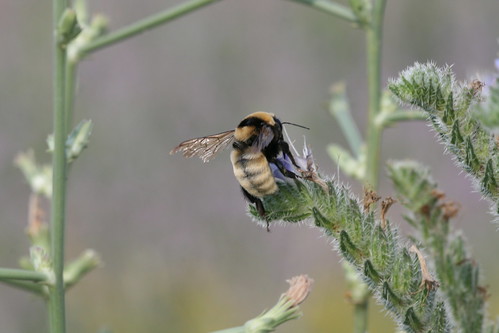科學家4月2日發表一項評估全歐68種大黃蜂物種存續狀況的研究,發現歐洲有17種大黃蜂面臨滅絕危機。
這份報告由負責編制和維護瀕危物種紅皮書的世界自然保育聯盟(IUCN)所發表。研究主持人、IUCN歐洲生物多樣性負責人Ana Nieto說,「我們非常關切這個現象。大黃蜂受威脅的比例如此之高,可能嚴重影響糧食生產。」
和其他授粉昆蟲一樣,大黃蜂幫助植物繁殖並改善作物的產量,包括番茄、胡椒和其他多種蔬果和種子。歐洲最重要的5種授粉昆蟲中,大黃蜂就佔了3種。大黃蜂和其他的授粉昆蟲每年貢獻歐洲農業220億歐元。
「保護大黃蜂物種和棲地、重建崩壞的生態系統和推廣有益生物多樣性的農業方法,將會是逆轉歐洲大黃蜂數量急遽下降趨勢的關鍵。」Nieto說。
「許多大黃蜂物種棲息範圍很小而且數量很少。牠們的生活型態往往和寄主植物密切相關,因此一點環境上的小變動就可能威脅牠們生存。」歐洲授粉昆蟲存續狀態和趨勢研究小組和IUCN物種存續委員會大黃蜂專家小組成員Pierre Rasmont說。
根據研究,歐洲所有大黃蜂物種中有46%數量在減少,29%保持穩定,僅13%在增加中。
研究發現,氣候變遷、農業密集化、農地使用方式改變是大黃蜂的三大主要威脅。其他導致大黃蜂數量下降的原因包括農業廢料污染和都市開發造成棲息地流失。
歐盟最近禁用或限用數種危害蜜蜂的新菸鹼類殺蟲劑,也出資研究授粉昆蟲的生存狀況。「不過顯然這些努力還不夠。不只要將生物多樣性納入政策,還要讓公眾體認授粉昆蟲的重要性。」歐盟環境執委Janez Potocnik說。
氣候變遷帶來的氣溫升高和長期乾旱是大黃蜂棲地變化的元兇。
歐洲體型第二大的大黃蜂Bombus hyperboreus在IUCN紅皮書中列為易危,只生活在斯堪地那維亞苔原和俄羅斯的最北邊這些北極和次北極地區。氣候變遷很可能縮小牠們的棲地,造成數量減少。
土地使用方式和農業方式改變造成大黃蜂生活的自然環境消失,嚴重威脅歐洲大黃蜂的生存。
保護等級為極危的大黃蜂Bombus cullumanus,因為棲息地的破碎,加上農業方式改變導致牠們的主要食物苜蓿消失,過去10年內數量已減少超過80%。過去曾經分布廣泛的Bombus cullumanus,現在只在全歐零星區域偶爾出現了。
歐洲體型最大的大黃蜂Bombus fragrans則列入為瀕危,也受到農業密集化的威脅。農業密集化摧毀了牠們位於烏克蘭和俄羅斯乾草原的自然棲地。
在農業地區周邊設置多花和多野生動物的緩衝帶以及保留草地等措施能有效減緩大黃蜂數量減少。這些緩衝帶和草地能提供蜜蜂食物,讓授粉昆蟲數量穩定,進而有助歐洲糧食安全。
Seventeen of the 68 species of European bumblebees are threatened with extinction, finds a new study assessing the species group at the European level.
“We are very concerned with these findings. Such a high proportion of threatened bumblebees can have serious implications for our food production,” said study coordinator Ana Nieto, European biodiversity officer with the International Union for the Conservation of Nature, IUCN, which maintains the Red List of Threatened Species.
Bumblebees, like other pollinators, allow plants to reproduce and improve the production of crops, such as tomatoes, peppers and many other types of fruit, vegetables and seeds.
Of the five most important pollinators of European crops, three are bumblebee species. Together with other pollinators, bumblebees contribute more than 22 billion euros to European agriculture per year.
“Protecting bumblebee species and habitats, restoring degraded ecosystems and promoting biodiversity-friendly agricultural practices will be essential to reverse the negative trends in European bumblebee populations,” said Nieto, releasing the study’s findings on Wednesday.
”Many of these species live in very restricted areas and in low numbers,” said Pierre Rasmont, member of the STEP team and the IUCN Species Survival Commission’s Bumblebees Specialist Group. “They are often extremely specialized on their host plants, which makes them susceptible to any environmental change.”
According to the study, 46 percent of all bumblebee species in Europe are in population decline, 29 percent are stable and 13 percent are increasing.
Climate change, the intensification of agriculture and changes in agricultural land are the main threats to the species, the study finds. Other reasons for their decline include pollution from agricultural waste and loss of habitat due to urban development.
The European Union recently banned or restricted the use of several neonicotinoid insecticides that are dangerous to bees and is funding research into status of pollinators.
“However,” said EU Environment Commissioner Janez Potocnik, “efforts clearly need to be scaled up, not least through better mainstreaming of biodiversity into other policies, but also to raise awareness about the benefits that pollinators bring.”
Climate change, through increasing temperatures and long periods of drought, is responsible for major changes in bumblebee habitat.
Bombus hyperboreus, the second largest bumblebee of Europe, listed as Vulnerable on the IUCN Red List, is strictly associated with Arctic and Subarctic regions and only lives in the Scandinavian tundra and in the extreme north of Russia. Climate change is likely to reduce the area of its habitat, leading to population decline.
Changes in land use and agricultural practices that result in the loss of the species’ natural environment also represent a serious threat to many bumblebees in Europe.
The geographic range of the Critically Endangered Bombus cullumanus has shrunk by more than 80 percent in the last 10 years following habitat fragmentation and changes in farming practices which involve removing clovers – its main forage. Once widespread, it now only occurs in a few scattered locations across Europe.
Europe’s largest bumblebee, the Endangered Bombus fragrans, is also threatened by the intensification of agriculture, which is destroying its native habitat in the steppes of Ukraine and Russia.
Measures such as increasing the margins and buffer strips around agricultural fields that are rich in flowers and wildlife and the preservation of grasslands are seen as effective tools in alleviating the rapid decline in bumblebee species. They can provide bees with forage and help underpin stable populations of pollinators, whose survival is crucial for European food security.
※ 全文及圖片詳見:ENS








